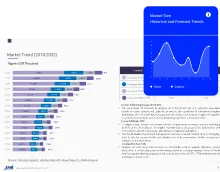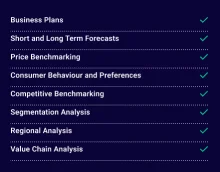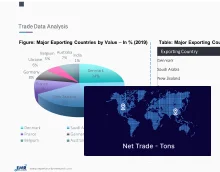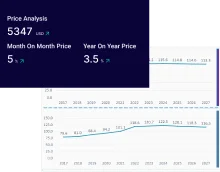
Consumer Insights
Uncover trends and behaviors shaping consumer choices today
Procurement Insights
Optimize your sourcing strategy with key market data
Industry Stats
Stay ahead with the latest trends and market analysis.
The Expert Market Research report, titled “Fruit Beer Manufacturing Plant Project Report 2025 Edition: Industry Trends, Capital Investment, Price Trends, Manufacturing Process, Raw Materials Requirement, Plant Setup, Operating Cost, and Revenue Statistics” includes various aspects that are critical for establishing a fruit beer plant. These include infrastructure requirements, transportation requirements, utility specifications, and financial and economic analysis, among others.






The demand for fruit beer is experiencing significant growth, driven largely by a shift in consumer preferences towards healthier, low-alcohol options. According to a recent survey, nearly 55% of millennials prefer beverages with lower alcohol content, reflecting a broader trend of mindful drinking. Fruit beers typically feature an alcohol by volume (ABV) ranging from 3% to 5%, making them an attractive alternative to traditional beers, which often exceed 6% ABV. One such example is "Raspberry Ale” offered by breweries like Dogfish Head Craft Brewery, which combines the refreshing taste of fruit with a lower alcohol content. Additionally, the craft beer movement has led to an explosion of microbreweries experimenting with unique fruit flavours, such as mango and passionfruit, further enticing consumers to explore this category.
Social trends also play a crucial role in the rising popularity of fruit beer. With more people seeking social experiences that do not revolve around heavy drinking, there is a growing market for flavourful yet lighter alcoholic beverages. A study indicated that 47% of consumers aged 21-34 reported enjoying fruit-flavoured beers as part of their social outings. The increased availability of these beverages in bars and restaurants has made them more accessible; for instance, establishments like The Beer Hall in New York City feature extensive menus highlighting local fruit beers. This accessibility, combined with the appeal of unique flavours and the perception of health benefits, positions fruit beer as a compelling choice for modern consumers looking for enjoyable and sociable drinking experiences.
Other elements to consider while establishing a fruit beer plant include raw material sourcing, workforce planning, and packaging. The production of fruit beer relies on malt, hops, yeast, and water. Malt provides the sugars needed for fermentation, while hops contribute bitterness and aroma. Yeast is essential for converting sugars into alcohol, and water, which makes up about 95% of beer, significantly influences the flavour profile. In addition, various fruits such as apples, cherries, grapes, raspberries, mango, peaches, and blueberries are often added to enhance flavour. Breweries may use fresh, frozen, or pureed fruits, with some opting for fruit extracts for consistency. This practice not only creates unique flavour profiles but also supports local agriculture by sourcing fruits from nearby farms. For example, craft breweries frequently experiment with seasonal fruits to produce limited-edition brews.
Moreover, to help stakeholders determine the economics of a fruit beer plant, project funding, capital investments, and operating expenses are analyzed. Projections for income and expenditure, along with a detailed breakdown of fixed and variable costs, direct and indirect expenses, and profit and loss analysis, enable stakeholders to comprehend the financial health and sustainability of a business. These projections serve as a strategic tool for evaluating future profitability, assessing cash flow needs, and identifying potential financial risks.
Fruit beer is a unique category of beer that incorporates fruit as a primary or secondary flavouring. The taste can range from sweet to tart and can be made using various fruits such as cherries, raspberries, and peaches. The origins of fruit beer trace back to ancient civilisations, with evidence suggesting that Neolithic Chinese villagers brewed fruit-based beverages over 9,000 years ago. Ancient Egyptians also added dates and pomegranates to their beers. The modern tradition of fruit beer began in the early 20th century with Belgian brewers creating cherry flavuored Krieks and other fruit Lambics.
Fruit beer colour can vary significantly, often ranging from pale gold to deep red, depending on the fruit used; for instance, cherries impart a vibrant red hue due to their high anthocyanin content. Clarity can also differ; some fruit beers may appear hazy due to suspended particles from fruit pulp or yeast. In terms of mouthfeel, fruit beers tend to be lighter and drier, reflecting the fermentable sugars derived from the added fruits.
Fruit beers typically have a pH level around 3.0 to 4.5, which is lower than standard beers, contributing to a pleasantly tart flavour profile. Their bitterness, measured in International Bitterness Units (IBU), is often lower than 20 IBU, as brewers frequently use low-alpha hops to complement rather than overpower the fruit flavours. Additionally, these beers are rich in antioxidants, with higher levels of phenolic compounds and flavonoids due to the inclusion of fruits, potentially offering added health benefits.
The production process of fruit beer begins with selecting premium malted grains, typically barley or wheat, and choosing fruits such as cherries, raspberries, dates, grapes, or peaches. The fruits are thoroughly cleaned and chopped/crushed to maximise flavour extraction. Next, the grains undergo malt preparation, where they are soaked and germinated to activate enzymes that convert starches into fermentable sugars. After milling the grains into a coarse powder, they are mixed with hot water (around 150-160°F or 65-71°C) in a process called mashing.
Once the wort is separated from the solid grain residue through lautering, it is boiled for approximately 60 minutes to sterilise and extract hop flavours. Hops are added during this stage to provide bitterness and aroma. The boiled wort is then rapidly cooled to a fermentation temperature of around 65-75°F (18-24°C) before oxygen is introduced to promote yeast activity.
Yeast is pitched into the cooled wort for primary fermentation, which lasts about one to two weeks as sugars are converted into alcohol and carbon dioxide. Following this, the beer undergoes secondary fermentation for an additional one to three weeks, allowing flavours to mature and sediment to settle. Finally, the beer is filtered to remove any remaining solids before being bottled or kegged.

Read more about this report - REQUEST FREE SAMPLE COPY IN PDF
In 2024, global beer consumption is projected to reach approximately 188 million kiloliters, with the Asia Pacific region experiencing substantial growth. For instance, beer consumption in India is expected to increase by over 10% annually. This will also contribute to growth of the fruit beer market. The number of bars and restaurants is also on the rise, with estimates suggesting that India will see an increase of around 15,000 new establishments by the end of 2024, enhancing the availability of fruit beers.
Moreover, in Europe, the number of microbreweries has surged to over 10,000 in countries like Germany and the UK. This growth is fuelled by a strong consumer preference for local and craft beers, with reports indicating that nearly 30% of beer drinkers in these regions prefer craft options. Additionally, the demand for low-alcohol and alcohol-free beverages is rising; in the UK alone, sales of alcohol-free beer have increased by more than 30% in recent years. These trends have also facilitated market expansion. The growth of online retail channels further facilitates access to a diverse range of fruit beers, contributing to the market's growth.
A detailed overview of production cost analysis that evaluates the manufacturing process of fruit beer is crucial for stakeholders considering entry into this sector. Furthermore, stakeholders can make informed decisions based on the latest economic data, technological innovations, production process, requirements of raw materials, utility and operating costs, capital investments by major players, pricing strategies, and profit margins.
Below are the sections that further detail the comprehensive scope of the prefeasibility report for a fruit beer production plant:
Market Dynamics and Trends: Factors such as innovating product launches are significantly affecting market conditions in the fruit beer sector. In January 2025, United Breweries Ltd. (UBL) expanded its Kingfisher brand portfolio by launching two new beer variants: Lemon Masala and Mango Berry Twist. These flavours are designed to appeal to younger consumers, particularly Gen Z, and are currently available in Goa and Daman. This move follows the successful launch of Kingfisher Storm in 2017, which also targeted a younger demographic. UBL aims to strengthen its market position as the largest-selling beer brand in India, leveraging innovative fruit flavours to attract a broader audience. Understanding these demands and trends helps other businesses align their production plans in the fruit beer market as well.
Profiling of Key Industry Players: Leading manufacturers in the fruit beer market include All Saints Brewing Company, Bell's Brewery Inc. (Lion), Brewery Ommegang, Founders Brewing Co. (Mahou San Miguel), Golden Road Brewing (Anheuser-Busch Companies LLC), Lindemans Brewery, Lost Coast Brewery, New Belgium Brewing Company, and New Glarus Brewing Company. Recently, All Saints Brewing Company launched a new fruit-infused beer called Peach Punch, while Bell's Brewery introduced their seasonal Cherry Stout. Brewery Ommegang has expanded its offerings with a new Raspberry Wheat, and Founders Brewing Co. released a limited-edition Mango IPA. Additionally, Golden Road Brewing debuted their popular Mango Cart, which quickly gained traction among younger consumers. Meanwhile, Lindemans Brewery dominates due to its classic fruit lambics, including the renowned Framboise (raspberry) and Peche (peach), while New Belgium Brewing Company is focusing on natural ingredients for its seasonal fruit beers like the Crisp Apple Ale.
Economic Analysis: Capital expenditure (CAPEX) analysis provides stakeholders the knowledge about required investments in advanced technologies, efficient machinery, and necessary infrastructure. Investing in high-capacity mixing equipment, such as a continuous mixer or high-shear mixer, can improve production efficiency by 20-30%. Investing in energy-efficient systems, such as combined heat and power (CHP) systems could reduce energy consumption by up to 30%, as these systems use waste heat from production processes to generate electricity and provide heating.
Fluctuations in fruit beer prices are influenced by seasonal availability of fruits, global trade policies, and economic conditions. The availability of specific fruits, such as raspberries and peaches, can vary due to climate conditions and harvest yields, directly impacting production costs. Currently, raspberry prices are approximately USD 12.84 per kg in the U.S., more than double the price from the same period last year, due to constrained supply and increased demand. Similarly, peach prices have seen a rise, with averages reaching around INR 6000 per quintal (or INR 60 per kg) in India, reflecting a robust harvest and increasing applications in various food products.
Additionally, trade rules and tariffs can affect the import costs of exotic fruits used in brewing, further influencing retail prices. Economic conditions also play a significant role; during periods of economic growth, consumers tend to spend more on premium fruit beers, while in tougher economic times, they may opt for more affordable options. Furthermore, health trends pushing for lower-calorie options are prompting breweries to innovate with new flavours and formulations, which can also impact pricing strategies.
Establishing a fruit beer manufacturing facility requires a comprehensive financial investment that encompasses various elements critical to the project's success. The following sections detail these components:
Projected profit margins and effective product pricing strategies improve overall profitability. Manufacturers might target a profit margin of around 20-30%, achieved through strategic pricing based on raw material costs and prevailing market demand. Effective pricing strategies should consider fluctuations in raw material prices and competitive positioning within the market.
The establishment of a fruit beer manufacturing facility must comply with various regulatory frameworks that govern production standards. In India, the Food Safety and Standards Authority of India (FSSAI) has set specific regulations for alcoholic beverages, including rules regarding yeast content in beer. Regular beer is mandated to have no yeast presence, while draught beer can contain yeast up to a limit of 40 CFU (colony-forming units) to ensure health and safety during brewing and storage.
Additionally, manufacturers must adhere to state-specific regulations, such as those outlined in the Maharashtra Manufacture of Beer and Wine Rules, 1966, which require licensing for breweries and stipulate operational guidelines Compliance with these standards is crucial for ensuring product safety and quality, as well as for obtaining the necessary licenses to operate legally. Furthermore, adherence to international standards may also be necessary if the facility plans to export its products or use imported ingredients.
This prefeasibility report aims to equip potential investors and existing manufacturers with crucial insights to make informed decisions in the fruit beer industry.
*While we strive to always give you current and accurate information, the numbers depicted on the website are indicative and may differ from the actual numbers in the main report. At Expert Market Research, we aim to bring you the latest insights and trends in the market. Using our analyses and forecasts, stakeholders can understand the market dynamics, navigate challenges, and capitalize on opportunities to make data-driven strategic decisions.*
Get in touch with us for a customized solution tailored to your unique requirements and save upto 35%!
Basic Plan
USD 2,699
USD 2,429
Get Startedtax inclusive*
Raw Material and Product Specification, Raw material consumption, Process flow diagram
Machinery Cost, Working Capital
Utilities consumption, Operating cost, Overheads, Financing Charges, GSA , Packaging
Premium Plan
USD 3,699
USD 3,329
Get Startedtax inclusive*
Key Processing Information, Capital Investment Analysis, Conversion Cost Analysis
Raw material consumption and prices, Utilities consumption breakdown, By-Product Credit, Labour Charges Breakdown
Land and Site Cost, Equipment Cost, Auxiliary Equipment Cost, Contingency, Engineering and Consulting Charges
Enterprise Plan
USD 4,799
USD 4,079
Get Startedtax inclusive*
Key Processing Information, Capital Investment Analysis, Conversion Cost Analysis, Variable Cost Breakdown, Investing Cost Breakdown,
Breakdown of machinery cost by equipment, Auxiliary Equipment Cost, Piping, Electrical, Instrumentation
Cost of Construction, Plant Building, Site Development Charges
Land Cost, Development Charges
Dynamic Spreadsheet (Unlocked)
*Please note that the prices mentioned below are starting prices for each bundle type. Kindly contact our team for further details.*

Basic Plan
USD 2,699
USD 2,429
Key Processing Information
Raw Material and Product Specification, Raw Material Consumption, Process Flow Diagram
Capital Investment Analysis
Machinery Cost, Working Capital
Conversion Cost Analysis
Utilities Consumption, Operating Cost, Overheads, Financing Charges, GSA , Packaging

Premium Plan
USD 3,699
USD 3,329
All Contents of Basic Report
Key Processing Information, Capital Investment Analysis, Conversion Cost Analysis
Variable Cost Breakdown
Raw Material Consumption and Prices, Utilities Consumption, Breakdown By-Product Credit, Labour Charges Breakdown
Investing Cost Breakdown
Land and Site Cost, Equipment Cost, Auxiliary Equipment Cost, Contingency, Engineering and Consulting Charges

Enterprise Plan
USD 4,799
USD 4,079
Includes all Report Content
Key Processing Information, Capital Investment Analysis, Conversion Cost Analysis, Variable Cost Breakdown, Investing Cost Breakdown,
Equipment Cost Breakdown
Breakdown of Machinery Cost By Equipment, Auxiliary Equipment Cost, Piping, Electrical, Instrumentation
Land and Construction Cost Details
Land Cost, Development Charges, Cost of Construction, Plant Building, Site Development Charges
Dynamic Excel Cost Model
Dynamic Spreadsheet (Unlocked)
*Please note that the prices mentioned below are starting prices for each bundle type. Kindly contact our team for further details.*
Flash Bundle
Number of Reports: 3
20%
tax inclusive*
Small Business Bundle
Number of Reports: 5
25%
tax inclusive*
Growth Bundle
Number of Reports: 8
30%
tax inclusive*
Enterprise Bundle
Number of Reports: 10
35%
tax inclusive*
How To Order
Our step-by-step guide will help you select, purchase, and access your reports swiftly, ensuring you get the information that drives your decisions, right when you need it.

Select License Type
Choose the right license for your needs and access rights.

Click on ‘Buy Now’
Add the report to your cart with one click and proceed to register.

Select Mode of Payment
Choose a payment option for a secure checkout. You will be redirected accordingly.
Track prices with detailed trend reports.

Analyse trade data for supply chain insights.

Leverage cost reports for smart savings

Enhance supply chain with partnerships.

Gain insights to stay ahead and seize opportunities.

Get insights & trends for a competitive edge.

Track prices with detailed trend reports.

Analyse trade data for supply chain insights.

Leverage cost reports for smart savings

Enhance supply chain with partnerships.

Gain insights to stay ahead and seize opportunities.

Get insights & trends for a competitive edge.

Track prices with detailed trend reports.

Analyse trade data for supply chain insights.

Connect For More Information
Our expert team of analysts will offer full support and resolve any queries regarding the report, before and after the purchase.
Our expert team of analysts will offer full support and resolve any queries regarding the report, before and after the purchase.
We employ meticulous research methods, blending advanced analytics and expert insights to deliver accurate, actionable industry intelligence, staying ahead of competitors.
Our skilled analysts offer unparalleled competitive advantage with detailed insights on current and emerging markets, ensuring your strategic edge.
We offer an in-depth yet simplified presentation of industry insights and analysis to meet your specific requirements effectively.



Australia
63 Fiona Drive, Tamworth, NSW
+61-448-061-727
India
C130 Sector 2 Noida, Uttar Pradesh 201301
+91-723-689-1189
Philippines
40th Floor, PBCom Tower, 6795 Ayala Avenue Cor V.A Rufino St. Makati City,1226.
+63-287-899-028, +63-967-048-3306
United Kingdom
6 Gardner Place, Becketts Close, Feltham TW14 0BX, Greater London
+44-753-713-2163
United States
30 North Gould Street, Sheridan, WY 82801
+1-415-325-5166
Vietnam
193/26/4 St.no.6, Ward Binh Hung Hoa, Binh Tan District, Ho Chi Minh City
+84-865-399-124
United States (Head Office)
30 North Gould Street, Sheridan, WY 82801
+1-415-325-5166
Australia
63 Fiona Drive, Tamworth, NSW
+61-448-061-727
India
C130 Sector 2 Noida, Uttar Pradesh 201301
+91-723-689-1189
Philippines
40th Floor, PBCom Tower, 6795 Ayala Avenue Cor V.A Rufino St. Makati City, 1226.
+63-287-899-028, +63-967-048-3306
United Kingdom
6 Gardner Place, Becketts Close, Feltham TW14 0BX, Greater London
+44-753-713-2163
Vietnam
193/26/4 St.no.6, Ward Binh Hung Hoa, Binh Tan District, Ho Chi Minh City
+84-865-399-124
Share